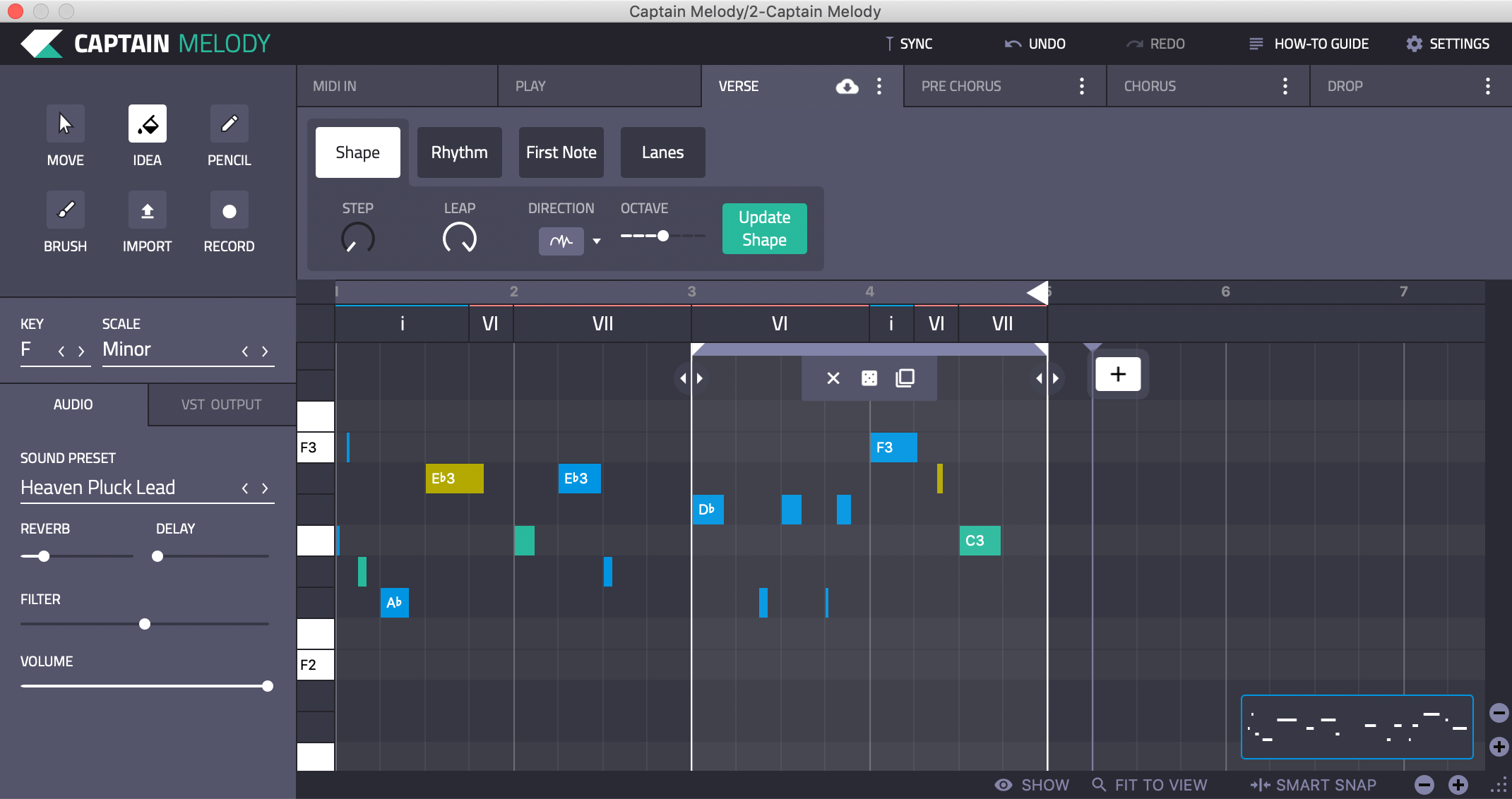Breaking the rules: how to write unusual melodies with mass appeal.

Whilst certain song structures and chord progressions have become fairly standard in pop music, many of the biggest hits nonetheless throw all convention out the window. A good songwriter will often turn the pop form on its head, reframing and juxtaposing existing genre tropes to create unusual yet unforgettable songs.
Daniel Hignell-Tully explores how, and when, to productively mess with listeners’ expectations.
Captain Melody 5.0
- Write melodies that suit your chord progression
- Connect the Melody plugin with Chords plugin
- Apply different rhythms
- Apply arpeggiators that move your MIDI notes
- Adjust the tension between the Chords and Melody
- Hear the melody played with 100+ different sounds
A formula for originality?
Writing music can often be a battle between understanding a formula – which notes go with which notes, and how they are distributed across your instruments – and trying not to be formulaic.
Whilst being utterly original in every way might not be the goal of many songwriters, no one wants their work to sound derivative. Genres are defined by rules concerning style, tempo, mood, instrumentation, and so on. Which begs the question: Is it possible to both follow the rules and create an original, Unusual melodies that stands out from the crowd?
Lady Gaga – Bad Romance
Leading with the vocal melody.
Lady Gaga is arguably the queen of weird pop music, and an analysis of her 2009 hit ‘Bad Romance’ shows us exactly why. On some levels, its a fairly standard pop song. An initially jarring harpsichord intro gives way to big trance-inspired synths, and on the surface, the song seems to follow a fairly regular verse/pre-chorus/chorus structure throughout.
Once you start to break down the sections, however, it becomes clear that something much stranger is at work. Vital to the songs success is its highly unusual treatment of the main vocal. Rather than attempting to impart meaning in a traditional lyrical sense, it instead serves as an additional melody that transcends the confines and expectations of each section.
Gaga uses two unusual non-linguistic techniques: melismatic – as seen on the opening chorus (A harmonic Minor) – in which a single syllable is carried across multiple notes; and syllabic – as heard in the infamous ‘Ra Ra’ verses (C Major)- where each syllable is assigned its own note.
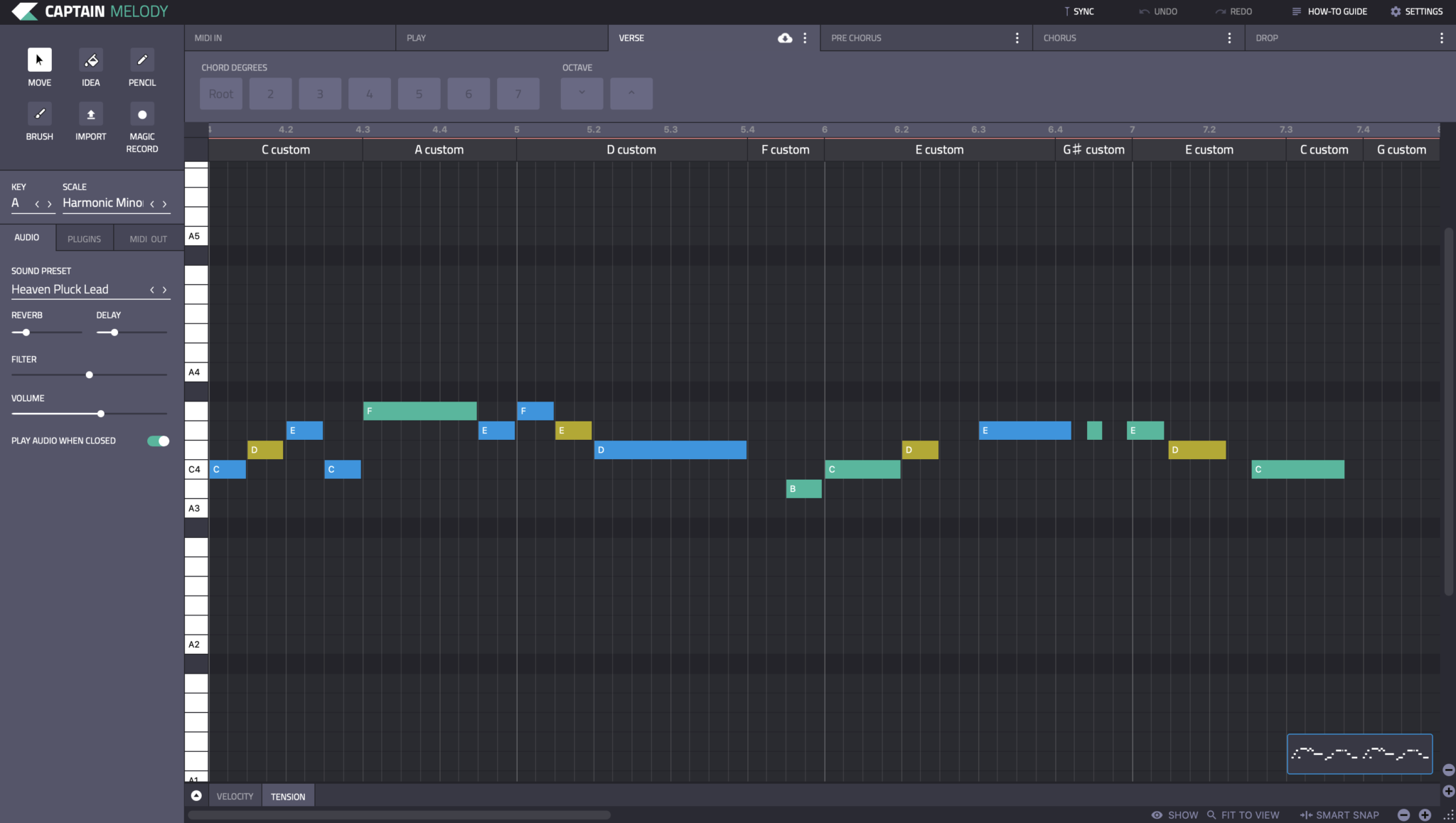
(FIG A: The vocal chorus melody, in A Harmonic Minor’)
Confounding expectations – but not too much.
Whist the use of melisma (slowing the music down) to emphasise a chorus melody is not unusual within pop music, Lady Gaga’s usage of it is. By using it before any ‘proper’ verse or chorus, she cements the song’s core melodies in the listener’s head.
Simultaneously, their inclusion foregrounds the tracks harmonic premise. In this case, she confounds expectations by shifting between the complementary scales of C major and A Harmonic Minor. What is more, by orientating the remaining lyrics firmly around an extended repetition of the song’s title, Gaga provides a familiar and ingrained frame upon which the numerous changes that follow can be placed.
Somehow, she manages to balance these unusual melodies without completely disorientating the listener. Indeed, the phrase ‘Bad Romance’ is uttered almost 30 times throughout its 5-minute run-time!
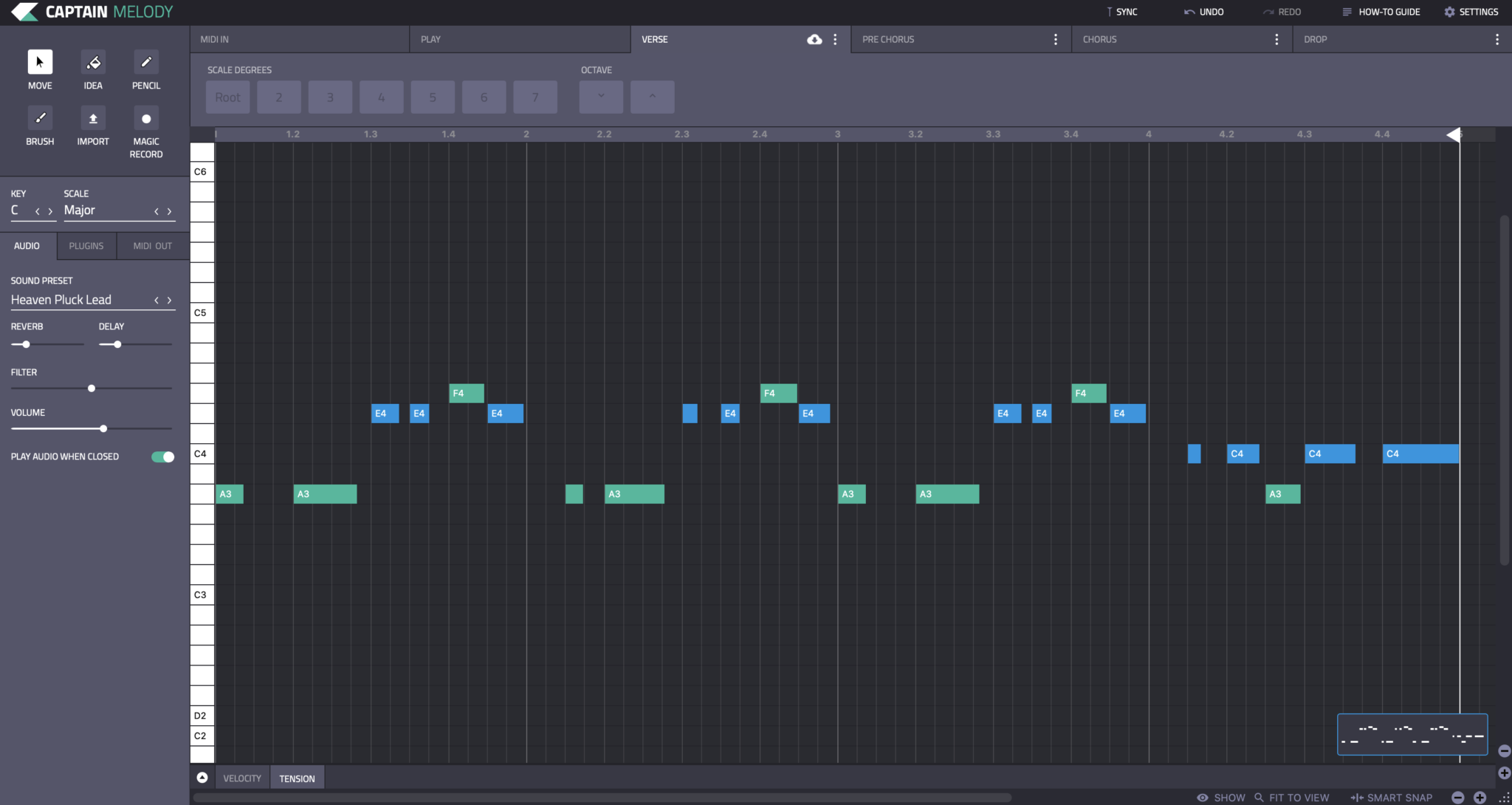
(FIG B: The vocal ‘Ra’ verse melody. Notice it is in C Major – however all these notes would work in A Harmonic Minor too).
The art of sign-posting.
Bad Romance succeeds by constantly letting the listener know what is coming next ahead of time, a process known as sign-posting. To join the chorus with the verse, Gaga employs a chord progression that contains both the G of the C Major scale, and the G# of the A Harmonic Minor. Since both notes occur only fleetingly they don’t disturb the listener – such brief out of keynotes are known as ‘accidentals’.
We hear them as an added character to the chosen scale, rather than a problem or mistake. The chorus can be considered as being in A Harmonic Minor, but with an accidental G that points to the C Major of the verse.
Likewise, the ascending lead-in that underpins the pre-verse, is used not only as a bridge back from the chorus, but as a bridge to the chorus, when it is later related as part of the middle 8. Once it is stripped of its accompanying vocal gymnastics, we hear that this unusual melody signposts the structural qualities of the chorus – a 4 note melody ascending the notes of the scale one by one.
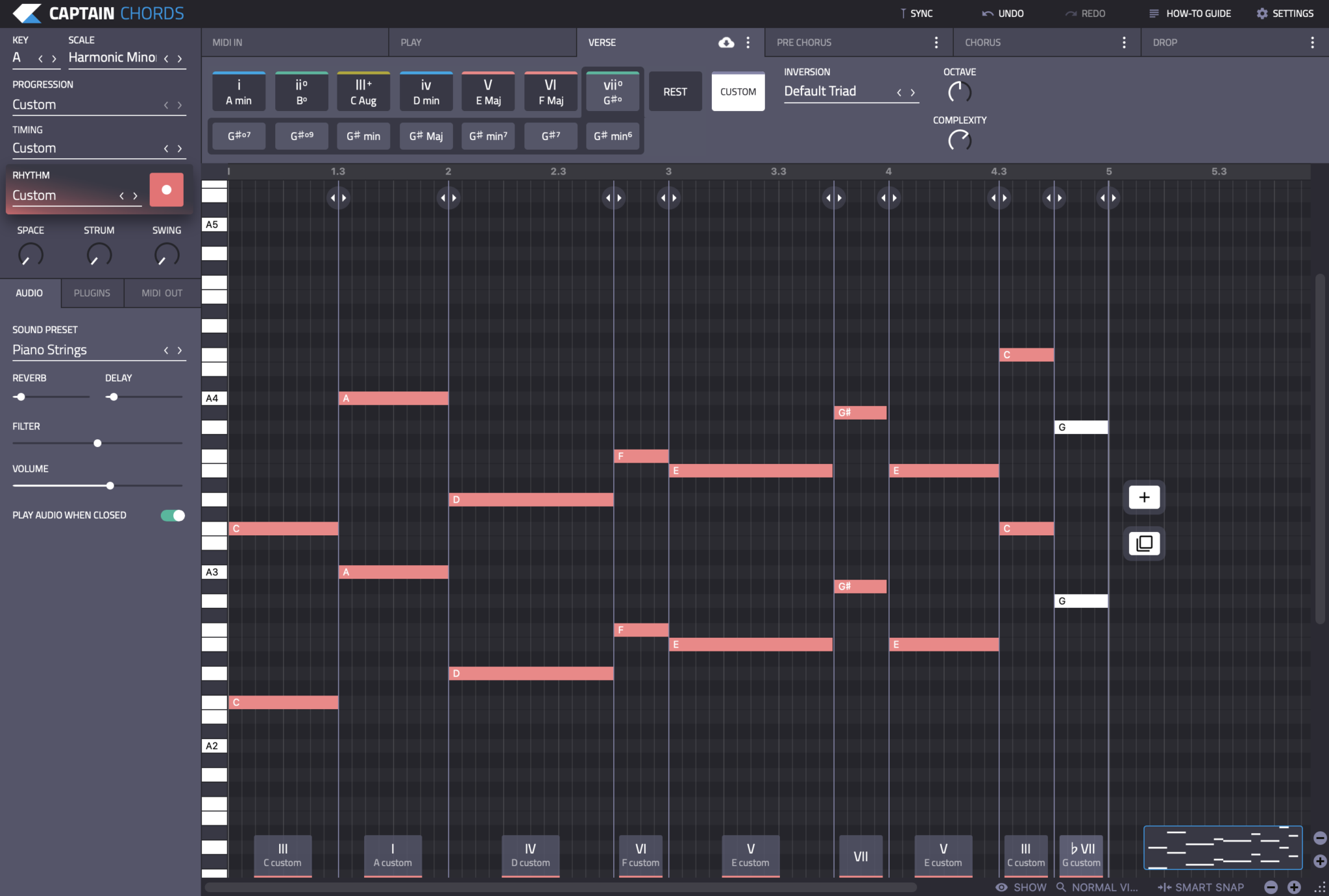
(Fig C) The chorus chord progression – note the ‘accidental’ G note that points to the C Major scale.)
Wouldn’t it be nice?
Of course, Lady Gaga isn’t the first pop composer to play with the rules. The Beach boy’s classic hit ‘Wouldn’t It Be Nice’ is equally unwilling to settle on a key, beginning in A minor before heading to F Major. Like Gaga, The Beach Boys also employ unusual techniques seemingly drawn more from classical composition that popular music – such as the use of ritardando. Here, to emphasise the final chorus, the music slows down considerably before entering a middle 8 that modulates between F Major and D Major – with different instruments playing in different keys.
It shouldn’t work, but it does.
By signposting the listener with an accompanying tempo change, the result is a section that feels deliberately out of keeping with the song as a whole. The approach provides an added level of power when the chorus, lead by a resounding thwack of the drums, returns once more for the final chorus.
Write chords faster with Captain Chords
- Write your own chord progressions
- Apply rhythms to your chords
- Set your Key and Scale for the entire song
- Explore different chords and discover your favorite combinations
- Compose music and write your own songs
- One touch plays 3 notes of the chords
Mixed OUT key.
Using Captain Chords in conjunction with Captain Melody is a great way of setting up some complementary scales to base your weird-pop track upon. Start by creating an instance of Captain Chords and choosing your first scale – for this example, let’s go with D Major. Using either a midi keyboard or the pencil tool, input a simple chord progression – here we have gone for a wistful ii-V-IV-vi progression. Next, open up captain Melody and link it to the chord progression – the software will automatically put us in the correct key.
Using the Idea tool, generate a simple melody, keeping the Leap and Step parameters quite low to stop things getting too complex. Once you’re happy, use the mouse to manually remove any A notes – we’ll find out why in a moment.
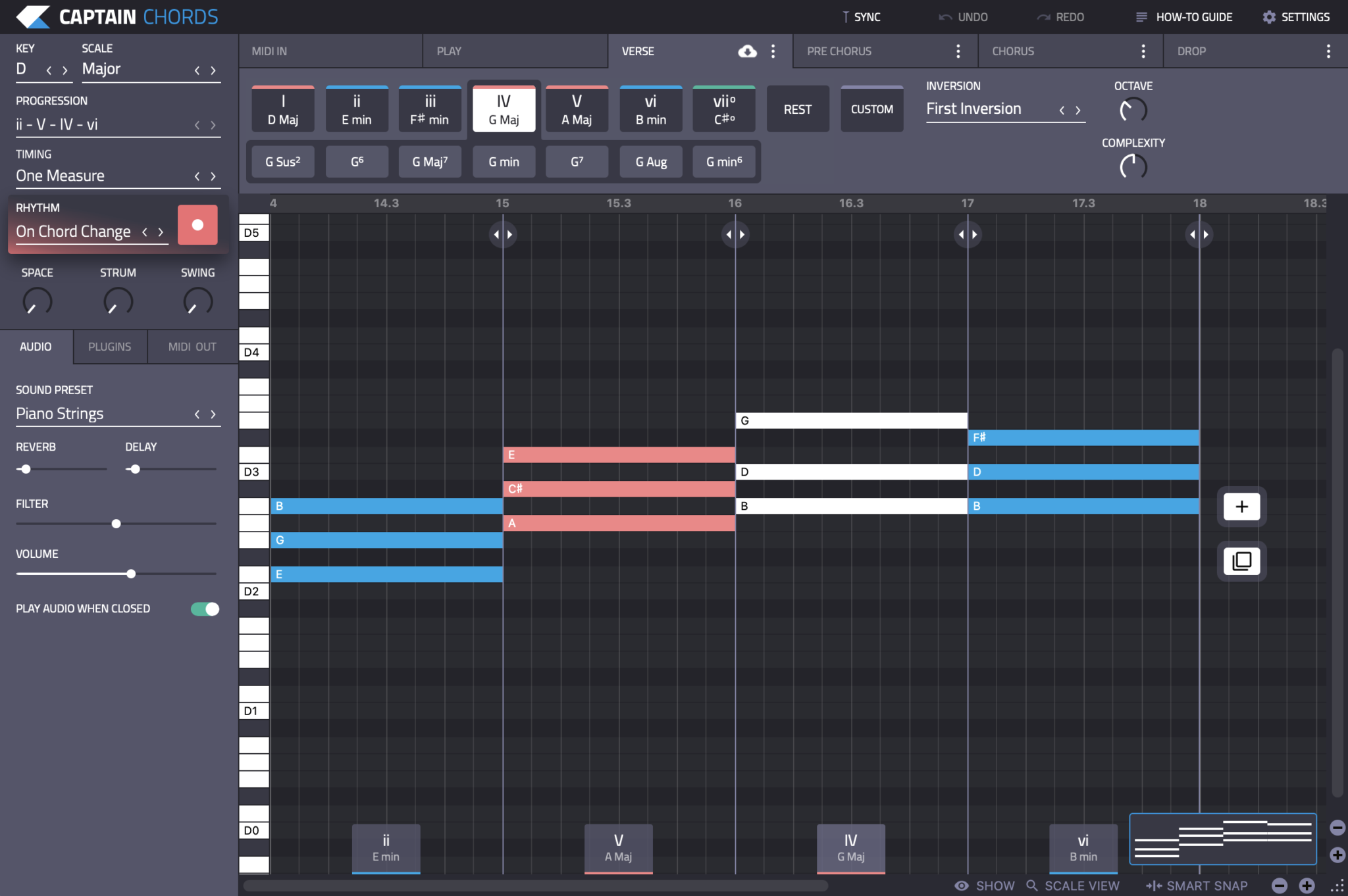
(Fig D) A chord progression in D Major)
Here’s where a bit more of the advanced theory comes in.
If we look at the notes of the scale, we know that D Major consists of D; E; F#/Gb; G; A; B; and C#/Db. What we want to do is choose a complementary scale – one that has most, but not all, of the same notes as D Major.
B Harmonic Minor works perfectly – its first 6 notes – B; C#/Db; D; E; F#/Gb; G; – are all in our original scale, with only the 7th scale degree – A#/Bb – conflicting.
Remember how we removed all the A notes from our melody? That’s because A is the only note that determines whether we are playing in D Major or B Harmonic minor – by removing it we have ensured that our melody fits into both scales.
Let’s give it a try. Open a new instance of Captain Chords and input a new progression – but this time, set it to B Harmonic Minor. Here, we’ve opted for an I—ii-III-VI progression. Playback our existing melody over this new chord progression and you will find that, whilst it changes the mood of our track as a whole, all of our notes are still playing perfectly in key.
We’ve created an unusual melody and blured the lines between two musical keys. Exciting!

(Fig E) Our melody in D Major – notice how we have removed any A notes.)
Signposting key changes by manually adjusting melodies.
Just like our Lady Gaga example, we can signpost the change from one key to another by slightly adjusting the melody. With our original melody playing over the D Major chords, we can manually adjust the last bar so that it includes the A#/Bb of B Harmonic Minor. To do this, we need to head to the bottom right of the Captain Melody interface, and switch ‘fit to view’ to ‘normal view’.
Now, instead of restricting us to the notes of our chosen scale, the software lets us add any note we wish. Using the pencil tool, change a couple of the shorter notes to A#.
As long as they are not too prominent in the melody – a little trial and error is a good idea here – these new accidentals won’t detract from the overall feel of the section. Nonetheless, they’ll be signposting the change in scale that will follow. When we play this manually adjusted melody over the new chord progression, the additional note now sounds completely at home, and allows both keys to sit alongside each other without sounding incongruous.
Rules are there to be broken.
There are plenty of other ways to play with the rules of pop music, and incorporate not only unusual harmonic developments, but a whole range of unexpected compositional devices. For a more recent example, check out Childish Gambino’s This Is America – a song that manages to incorporate not only a dramatic key change, but also a whole slew of music influences, from trap to gospel to industrial to R’n’B. Using Captain PLugins, and learning a few choice rules to break, you too can create a weird pop classic.
Childish Gambino – This Is America
Recap:
Throughout this article we have delved into a few music theory terms: Accidental – a note that fall outside of the previously set key. Usually, these appear very briefly.
Melisma – A single syllable sung across multiple notes.
Syllabic – a vocal melody where each syllable is given its own note.
Ritardando – a gradual decrease in speed.
About the author:

